
21 minute read
Admiral’s Corner: Time-Critical ORM and Starting the Year Right
Admiral's Corner From Commander, Naval Safety Center
Time-Critical ORM and Starting the Year Right
Advertisement
Success in safety involves identifying hazards, and then taking necessary steps to prevent them from becoming mishaps.
Maintainers have been doing that for years, and you’ve done your part this year…on and off duty. But success isn’t “doing it right” for a few days, weeks or months. It’s getting it right every day and every launch and every time you get in your car.
I want to take just a little time to share some facts about on- and off-the-job mishaps.
I had our people run statistics for maintenance-related mishaps for the last 10 years. I wanted to know what impact, if any, we’ve had with maintenance. The first part, I’m happy to say, is that maintenancerelated involvement in mishaps is small. Last year was exceptional, and your efforts actually lead to a dramatic reduction in maintenancerelated mishaps. However, in CY06, we still had 20 Class A, B or C mishaps involving 21 aircraft, and at a cost of $120 million.
What these numbers tell me is that we’re doing good, but we can and must do even better. You can see the numbers over the past 10 years on the accompanying chart.
We also have good news off duty. As I write this note, we are having the best year ever for private motor vehicle mishaps. Motorcycle-related mishaps also are down—best in the past five years. I hate saying too much too soon because there’s a lot of time left in the year, including the critical days of summer, but you have come through admirably to this point.
We will be successful, but only if this wonderful trend continues. So I need every maintainer to do what you’ve done in the past: Help to solve these issues permanently. Talk with your shipmates, make sure your people have plenty of rest, discuss ways to stay safe on and off duty, and use time-critical ORM. It takes only a second to be injured, so take a couple seconds to plan for your safety. Identify hazards and ask

yourself “what can hurt me or cause damage,” then take steps to reduce these risks, set controls, and keep checking yourself and your shipmates to make sure you adjust when things change or are different.
Before you start an evolution, ask yourself a simple question, “What’s different today?” and use the simple A, B, C and D process described on the next page.
Your continued hard work will make this the best year ever for mishaps.
RADM George Mayer
In This Issue:

By Dan Steber
The three levels of operational risk management (ORM) are in-depth, deliberate and time-critical. The first two imply a well thought-out process, where time is available for a well-defined plan. In this issue, I’ve shared stories that deal with time-critical ORM, which maintainers use most often.
Time-critical ORM is the type that maintainers do on the fly, sometimes without even thinking about it, but we must think about this part. It needs to be an integral part of maintenance each and every day. Timecritical ORM is used when there isn’t time to plan. It’s the review necessary anytime a job is attempted on short notice, or during the execution of a mission or job. It’s a critical step in safe maintenance and is a fundamental action in answering the question, “What’s different today?”
For example, the simple job of wiping down canopies. Start with the simple A, B, C, and D approach: You need to A=Analyze the situation. Look at the hazards surrounding the job you’re about to do. Quickly look at the things that can get you hurt or killed, whether its changing weather conditions, chemicals, slip and fall hazards, or any risk that might be present.
Next, B=Balance Your Resources: Ask yourself if you have the right number of people involved. What are the time constraints? Are the people knowledgeable about the task being attempted? Do you or the team have the right equipment to get the job done?
Once this mental notation is done, the next part is C=communication. It’s necessary to make sure everyone
Navy photo by MC3 Dominque Lasco

knows what is going on. Talk with other workers, the flight-deck chief, or maintenance control when the plan or conditions change. It might be necessary at times to let someone know that you cannot get the job done with the available resources. You also must communicate the need for any additional requirements, like people, equipment, PPE, tools, or other gear that might be necessary to get the job done safely.
The final part is D=Do and Debrief. Once the decision is made to go forward, you need to take the steps to get the job done, being careful to prevent anything from happening that can cause you or your team harm. Once the job is done, the task should be reviewed and debriefed for lessons learned.
Several stories in this issue show a lack of ORM. Maintainers admit their mistakes, as usual, but read these stories with a critical eye. Try to identify the steps that could have been done ahead of time or during execution to avoid the problems presented. Look for the cases where maintainers should have asked, “What’s different today?”
We can’t improve unless we look at lessons learned and improve on past mistakes. Repeat mishaps continue to occur. We backed or towed aircraft into objects. A tail rotor struck a tie-down strap during a maintenance turn. We dropped pods and drop-tanks. Access doors separated from aircraft, canopies were damaged, and other mishaps show that time-critical ORM is essential. Don’t let the same mistakes happen to you, your shop, or your squadron. You can make a difference.
Common Sense Goes a Long Way
By ABH3 Ashley Cypret
Some people refer to operational risk management as a formal approach to common sense. Whether that statement is true is debatable, but I wish I had used either to avoid an incident on the ship.
The day started out easy for the flight-deck crew on USS Iwo Jima (LHD-7), just a few maintenance and training flights for the embarked Marine Air Combat Element. It was mid-afternoon when we worked to get the flight deck ready for a RAS and VERTREP scheduled for the next day.
The deck was set up for the VERTREP when the CO announced on the 1MC that we had been ordered to leave for the coast of Lebanon to evacuate American-embassy personnel and citizens. Within a few hours, we were told to respot the flight deck for an early morning launch.
On the starboard elevator, AV8B Harrier maintainers requested a MEPP (mobile electric power plant) unit for an instrument power-check before takeoff. Our tractor king (TK) directed me to get the MEPP unit to the aircraft for some on-the-job training because I was being considered for the TK job. Even before I got on the MEPP, I reemphasized to him that I was not qualified for the MEPP unit and that I needed a phase sheet for it. The birdcage area of the Prowler can be dark and often requires a The actual or acting TK told me not to worry; he said a little training would help me get a better feel for the MEPP fl ashlight during maintenance. unit. Oh man was he ever wrong!
I was relieved to learn that the MEPP unit already was located next
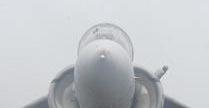
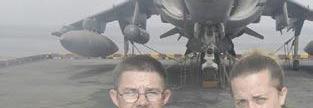

Driving MEPPs or towing aircraft on, off or around elevators can be tricky.

to the Harrier, and all we had to do was to hook up the power cord. The maintainers immediately did their testing, and the jet was up and ready for the morning launch. We disconnected the power cord from the Harrier, and I got on the MEPP unit to drive it off the elevator. Unfortunately, the only way to get off of the elevator was to drive along the painted red-and-yellow-square visual-landing-aid markings around the elevator deck edge, adjacent to the coaming. A hump exists between the elevator and the flight deck, where the elevator locks fit into the flight deck, and the TK advised me to drive over the hump.
I was a little tentative and hesitated for a few seconds before moving forward. My two front tires went over the obstacle without a problem, but my back tires got stuck. I felt pressure to get the MEPP unit clear of the elevator, so I had to give it a little more gas. Because everything happened so fast after I accelerated, I’m still not sure exactly what happened. The unit jumped forward with an almost sling-shot effect, and all I could see was the tail section of the Harrier approaching rapidly. I turned the steering wheel, hoping I would miss the tail of the jet and not hit the Harrier’s stabilator. I just as quickly decided my only option was to slam on the brakes and hope for the best. Fortunately, I was able to avoid a head-on collision but still scraped the stabilator. My right arm was dragged between the MEPP unit and the stabilator, requiring a trip to medical for a checkup and to make sure no carbon fibers were in my arm.
Navy photo by PH3 Angel Roman-Otero
The Harrier suffered minor damage that took a couple hours to fix, and the maintainers did a quick patch job, avoiding a missed mission.
Afterward, the TK and I went into flight-deck control to tell the handler and chief exactly what happened. We were told to write a statement and to document everything that had taken place. We then were sent to GSE to talk with the AIMD officer and LCPO. They immediately advised us that our licenses would be suspended until a full investigation could be done. It took about a month before it was completed, and we were cleared to operate again.
I learned a lot that day; the most important lesson was: Common sense goes a long way. I should have done an ORM review and asked myself these basic questions. Am I qualified? Do I have a license to be on this gear? Have I taken the proper classes for this gear? Since the answer to these questions was no, I should have used common sense and not have gotten behind the wheel.
Operational risk management will help prevent mishaps, and when we’re talking about multi-million dollar aircraft…no room for error exists.
Petty Officer Cypret works in the V-1 division aboard USS Iwo Jima (LHD-7).
The problem here is that she did identify her lack of license and qual, but the TK convinced her to do it anyway. She should have been more assertive.—RADM George Mayer
Lack of Time-Critical ORM
By PR3 (AW) Dusty Rather
One warm day in April, the Sailors of VAQ-139 were tasked with the arduous job of replacing the starboard engine on one of two aircraft on det at a forward air base in Iraq. We had been operating as a split squadron between this base and our carrier in the northern Arabian Gulf, so those of us in the desert sometimes had to make-do with the people available. This engine swap was no exception; although, we would come to wish it had been.
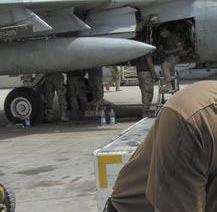

Making this job an “all hands” effort, we soon installed the new engine and had the jet ready to fly. On the final phase of the swap, and when the defective engine was to be placed into a transport container and sent to AIMD, we had a serious lack of communication. That problem could have brought on disastrous results.
The four other shipmates and I weren’t faced with equipment failure or any kind of weather interference; rather, it was a common item involved in most naval
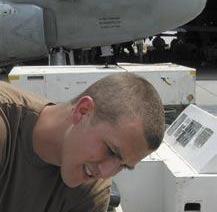
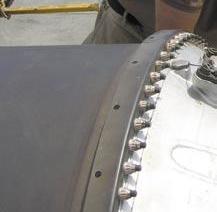
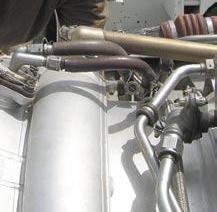
aviation mishaps: human error. We had not discussed thoroughly the steps in the process for removing the main-engine sling once the engine was in the crate. With only one AD on the scene, most everyone involved had little to no experience or even a basic understanding of what needed to happen with this engine and when. However, with the AD’s guidance, we mounted the engine in its container and unbolted the hoist sling from the engine.
The mech in charge of this process told me the sling was light, and we should be able to pull it off. His plan was to lift one end of the engine sling just enough to let us slide it clear. He positioned himself and prepared to lift one end of the sling.
About that same time, I noticed one of the other guys was reaching between the sling and the engine to retrieve a dropped bolt. Not seeing this action but ready to remove the sling nevertheless, the AD yelled, “Ready?” Before I

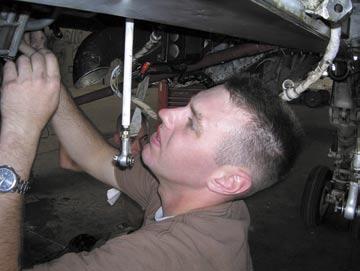
could tell him to wait for the other guy, he lifted his end of the sling up. Realizing the weight was too much for him, though, he immediately dropped it back down. Our shipmate who had been reaching for the bolt quickly pulled back his hand and saved it from being crushed.
A few excited words were exchanged, and tempers flared. The discussion was short-lived, and we quickly determined that we needed to communicate more effectively the next time, or the next person’s reflexes might not be as good.
Although we had dodged a serious injury, the point of this story is that Sailors need to learn from nearmisses, as well as real mishaps. We also learned that we must use ORM while going through every maintenance task beforehand. Determine the correct procedures, and make sure everyone understands their roles. It also is critical to communicate and make sure the work area is clear of hazards. We then need to adjust the plan as things change (what’s different today). What obstacles exist, and how we can avoid them to reduce risk.
Communication can be the strength or the death of any crew or squadron. Had we used the five steps of ORM (identify hazards, assess risk, make risk decisions, implement controls, and supervise), this task never would have reached the point where a Sailor was in jeopardy.
Petty Officer Rather works in the PR shop at VAQ-139.
Good example of what should have been a five-step ORM review becoming time-critical.—Ed.
Navy photo by MC3 Ron Reeves
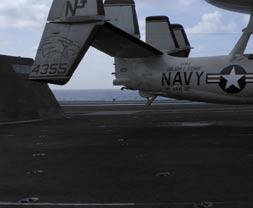



By AD1 Zamir Alvarez and AM1 Philip Carter
It was just another hot September day in the Northern Arabian Sea. The sun was rising around 0330 and setting at 1530. We were five months into a seven-month deployment. Two squadrons were deployed ashore, so the USS Enterprise (CVN-65) flight deck was unusually spacious. To our chagrin, it wasn't big enough.
We manned up the E-2C Hawkeye, call sign Screwtop 601, for the last day launch as the ship steamed into the setting sun. We had engines on line, were ready to taxi, and had time to spare for the scheduled launch. As 601 taxied to cat No. 1, I noticed a P-25 firefighting vehicle was parked inside the foul line on the port side of our catapult. This position wouldn’t be a problem if the bird ready to launch was a Hornet or other small aircraft. I ran up to the driver of the P-25 to let him know they needed to move because our E-2C wings didn’t have enough room to spread with the fire truck parked there.
We already had learned this lesson the hard way earlier in the cruise; however, parking on the port side of the catapult inside the foul line was a common practice. When we crunched a wing against the P-25 earlier on cruise, the handler directed the drivers to park outboard of the foul line on the starboard side. On this day, the P-25 driver didn’t heed the handler’s instruction.
After explaining to the driver that we needed more room for our wingspread, he started to move. Simultaneously, the yellowshirt directing our aircraft gave the signal to the pilot to spread the wings. As the wings were moving, I noticed that the driver of the P-25 had moved the fire truck just a few feet. Seeing this problem, I ran to the driver and told him he needed to move or the wing would hit the truck. He moved again but slowly because the jet blast deflector operators were in his way. I immediately gave the stop signal to the yellow shirt. As I did so, the flight-deck coordinator and QAR
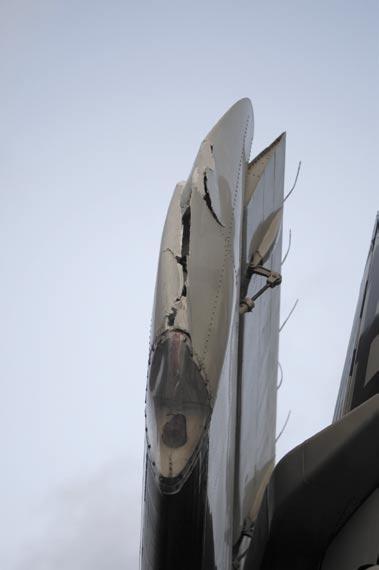
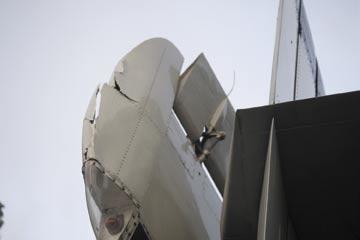
noticed the same problem, and they also signaled the aircraft director to stop.
This is where our communication failed. After seeing my signal, the yellowshirt relayed the same signal to the pilots in 601. The pilots saw that signal and, unaware that there was a dangerous situation developing near their left wing, they thought the signal was intended to stop the aircraft, instead of the wingspread. The pilots continued to hold the brakes, but they did not reverse the wings.
Unbeknownst to the pilots, the port wing clipped the P-25 and lifted the fire truck off the deck a few inches, destroying the outer wingtip. Needless to say, this problem downed the aircraft resulting in a failed launch.
A process that had been carried out multiple times, day and night, for the past five months, went totally wrong. It should have been easier, because the deck was less crowded, and we were in no rush. There were several hazards we faced that day, and if we had eliminated any one of them we could have prevented this crunch. The P-25 should not have been parked inside the foul line against the handler’s direction. The driver should have moved immediately when the problem was pointed out to him, and the other flight-deck personnel exacerbated the problem by standing in the path of the emergency vehicle. I should have given the wing-fold signal instead of the stop signal to remove any ambiguity. I should have given the appropriate signal the instant I realized that there might be a problem.
Complacency, error in executing proper flight-deck procedures, and a break down in communication resulted in the damage of an aircraft. Fortunately no one was hurt, but simple communication between airwing personnel and carrier flight-deck personnel could have prevented this crunch from ever happening.
Petty Officers Alvarez and Carter are assigned to the Screwtops of VAW-123.
By AT2 Jacob Kauffman
On a normal day during the strike group’s tailored ships training availability on board USS John C. Stennis (CVN-74), I made a mistake that landed me 14 days of convalescent leave and almost cost me a finger and part of my hand.
Our night-check schedule was the same, day in and day out. We’d sleep all day and work hard all night to get the major maintenance done to prepare the aircraft for the next day’s flights. One day before my incident, the ship was completing its final general-quarters (GQ) evaluation for TSTA. Since our berthing was near a damage-control station, GQ meant all of the airwing night shift participated from 1200 to 1900—right in the middle of our normal sleep period. Night shift worked from 1800 to 0730, so everyone had received only about four to five total hours of unbroken sleep in a 36-hour period. We certainly were tired and maintenance control

was aware of the situation. They had advised the supervisors to keep a careful watch on the crews and to work safely that night.
As the night-check supervisor of the avionics shop, I was the person who had to watch and make sure everyone was working safely, yet still try to finish our workload for the evening. Early in the morning, towards the end of the shift, the final task was to replace a trailing wire antenna (TWA). To complete it, we had to remove the cover that holds a spool of antenna wire, and swap out the five-pound drogue that attaches to the end of the wire. After the assembly was replaced, I sent the two PO3’s working with me to eat. Upon their return I was going to show them how to properly install the drogue.
When they returned from chow, a PO2 joined them who also never had performed this task before. We grabbed our tools and headed to the flight deck. Unfor
Navy photo by MC3 Ron Reeves
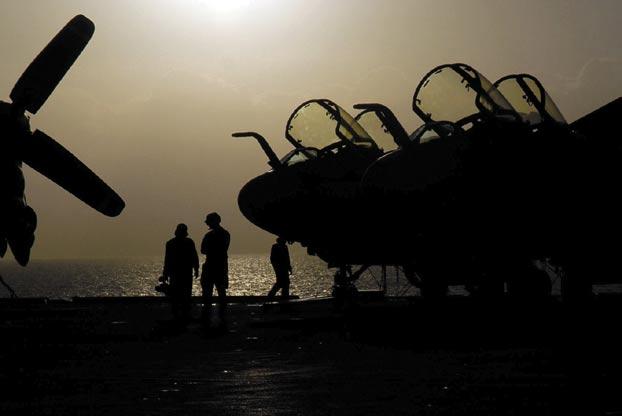
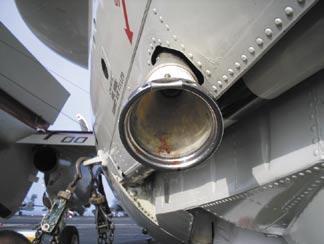
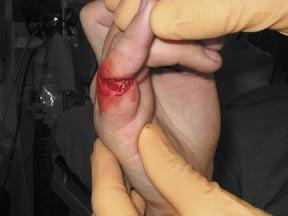
tunately, we forgot to grab the pub. On the way to the flight deck, one tech told me he had done the job before but had had trouble with some of the steps. I knew extra time would be required for OJT.
I started the job as I had many times before: The wire was pulled through the end of the aircraft, and I inspected the end of the wire that was sticking out. The wire had a kink and a spot where it looked worn. When a wire is damaged, all that has to be done is reel out more wire and cut off the damaged section. While the inexperienced techs were watching, I told one of the PO3s to turn on the HF1 TWA set inside the aircraft.
What we had forgotten in our tired state was to adhere to a bold warning in the procedure that requires the hydraulic-isolation valve circuit breaker to be pulled. I had done this procedure many times and thought I had set myself up for success.
The circuit breaker needs to be pulled in order for the aircraft to think it is airborne. The trailing-wire antenna works normally, only if the aircraft is weight-offwheels. If the circuit breaker is not pulled, the normal operation of the TWA is to immediately reel in because the aircraft is not airborne.
As soon as the system was turned on it worked as advertised. The aircraft sensed the landing gear was down in preparation for landing, and the antenna began to reel in. Unfortunately, it did so, with my hand inside the coil of wire. As the wire pulled in, the coil wrapped more tightly around my hand, pulling the wire and my hand into the end of the drogue receptacle. My hand firmly was stuck inside the coil as the wire continued tightening. I was stuck and couldn’t do anything.
A quick-thinking PO2 decided to take action. He grabbed the dykes out of the tool pouch and cut the wire wrapped around my hand. As he cut the wire, we could see blood running out of my hand. Another tech called away a medical emergency. The tech who had turned the system on came out to see what had caused all the commotion. I told him to run back into the plane and immediately shut off the system.
With the wire retracted and power shut off, little slack existed inside the spool that could be pulled out. The techs struggled a little more and finally were able to cut my hand free with the little slack available. They ran me down four decks to ship’s medical, with a brief stop to grab a cloth to control the bleeding.
Once at medical, the staff asked me if I was the medical emergency that was called on the flight deck! The ship’s corpsman went to work inspecting the wound only to verify I had separated the tendon and nerves in my right pinky finger. The severity of my wound and the separated tendon was beyond the ship’s capability. I needed to be flown to Balboa Naval Hospital for surgery. Within an hour of the incident, I was San Diego-bound.
At Balboa, the resulting surgery to fix my finger and reattach the tendons and nerves took seven hours. That step was the easy part. The consequences of my accident were two weeks convalescent leave and up to three months of physical therapy. Thanks to my peers and the medical staff, I have almost regained complete use of my hand.
The lesson learned is to slow down and use the pubs. Even when the task has been done many times before, time still should be taken to read the pubs slowly, so no step gets missed. I learned the real meaning that day about “written in blood.”
Extra time also should be taken when fatigue is a factor, because even the most routine task is far more dangerous when your head is not in the game.
Petty Officer Kauffman works in the AT shop at VAW-112.





